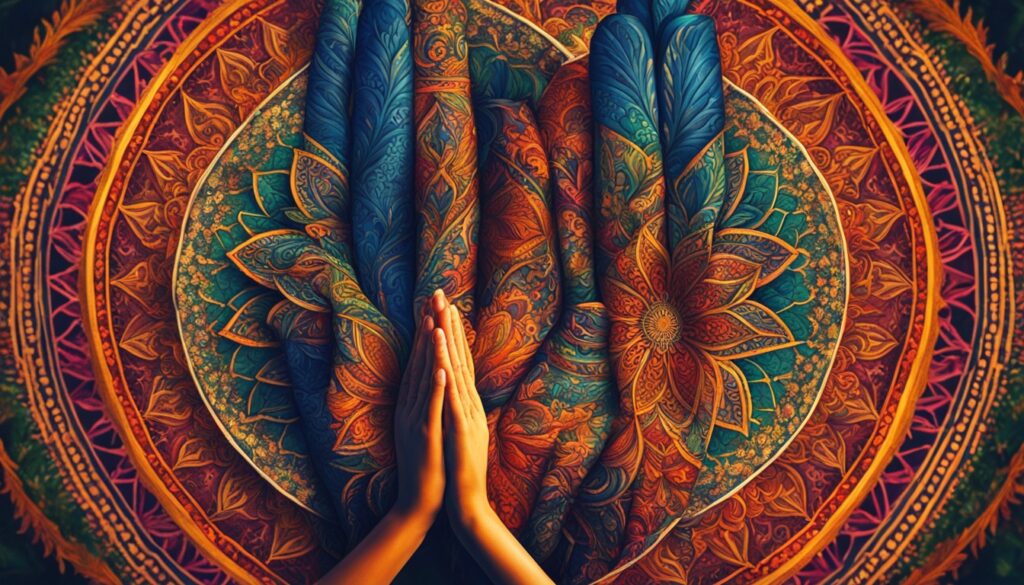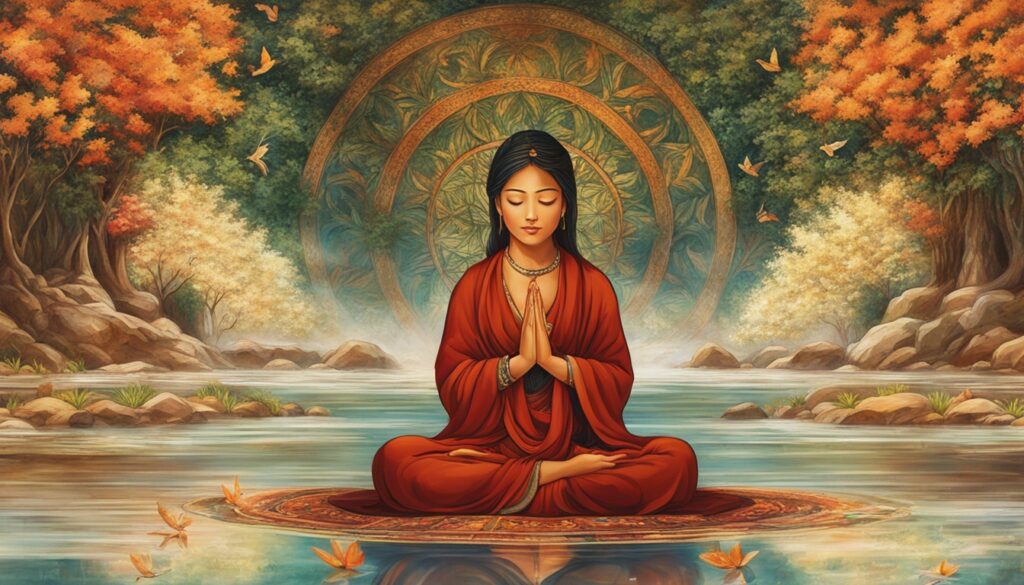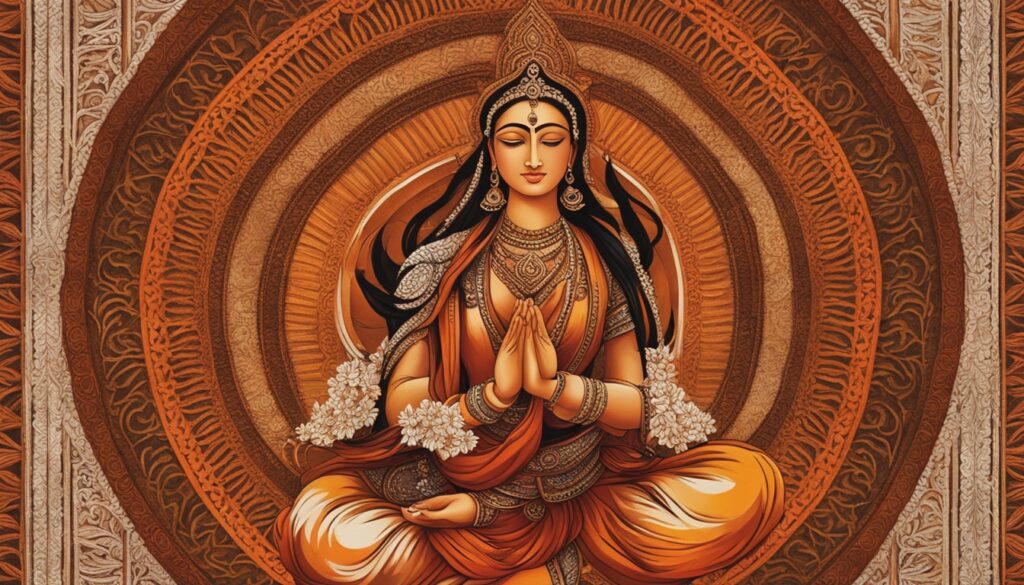“Namaste” is a greeting used in many spiritual practices and yoga communities worldwide. It’s a simple gesture that means unity, peace, and harmony. It shows a deep connection between people, promoting humility and respect for everyone’s inner divine.
In Hindi culture, “Namaste” means showing respect and unity. When people say “Namaste” and join hands at the heart, they honor the divine spark in each other. This creates a strong bond among people.
We will look into why Namaste is spiritually important. We’ll see its role in Indian culture and how it helps us connect with nature and the divine.
Spiritual Significance of Namaste

Namaste is a greeting from Sanskrit, deeply important in Indian culture. It means “I bow to you,” showing respect for the divine spark in everyone. This greeting honors the special value and divinity of the person in front of you.
The hands are placed like a lotus flower, a sign of purity and enlightenment. This helps bring peace and balance to the mind and body. Namaste shows respect, thanks, and love for oneself and others, linking two people spiritually.
Namaste is more than a hello; it’s about seeing our connection to all beings and a higher power. Folding the hands helps focus inward, deepening self-reflection and inner connection. It’s about seeing the divine in ourselves and others, creating unity and equality.
Namaste’s spiritual depth goes beyond just the hand gesture. It’s one of six ways to show respect in Hindu tradition. You can see Namaste in statues and old sculptures of gods in temples in India and Thailand. This shows its deep cultural and spiritual importance.
Namaste in Indian Culture

The hindu greeting “namaste” is a big part of Indian culture. It shows respect and connects people. Folding hands with “namaskar” is more than just a hello. It’s key in many rituals and spiritual acts in India.
“Namaste” shows the values of being humble and united. It believes we are all connected. These ideas are very important in Indian thought and spirituality. The word “namaste” is loved around the world for its deep respect and unity message.
Namaste is more than a simple hello. It’s a way to say hello to the divine in someone. Saying “namaste” means we see the sacred in each other. Joining our palms together shows we believe we are all one, despite our differences.
The “anjali mudra” is a special hand gesture for namaste. It comes from Indian dance and yoga. This gesture shows deep respect and love. Another similar gesture, the “namaskara mudra,” is also used in some parts of India.
Namaste has spread beyond India and is now known worldwide as a sign of respect and peace. It’s a tradition that brings people together, no matter where they’re from.
Namaste and Well-being
The namaste gesture makes us feel better and more mindful. When we say namaste, we focus on the now and the person we’re with. This helps us relax and think clearly.
Doing namaste makes our mind and body calm. It touches special points in our fingers that connect to our brain. This helps us feel peaceful and balanced, away from daily stress.
In Hindu culture, namaste means we see the divine in everyone. It reminds us we’re all connected to something greater. This makes namaste good for our well-being, bringing us closer to each other.
Yoga and Eastern practices are getting more popular worldwide. Namaste is now a sign of peace and respect. Adding namaste to our day can make us more present, kind, and happy.
Connecting with Nature Through Namaste

The traditional Indian greeting of Namaste is more than just a hello. It connects us with the world around us. In Hindu culture, the sun, moon, and stars are seen as divine. Saying Namaste to them shows respect for nature’s divinity.
When we bring our palms together and bow our heads, we say “Namaste”. This shows we see the divine in all living things, including nature. It makes us feel closer to the earth and thankful for what it gives us.
With Namaste, we say thanks for nature’s beauty and magic. From the sun to the stars, it helps us feel in tune with nature. It makes us understand our role in the world better. By using Namaste, we connect deeply with nature and live in harmony with it.
Namaste as a Global Symbol

Namaste, a traditional Hindu greeting, is now a symbol of unity and respect worldwide. It started in Indian culture but is now popular in yoga and meditation globally. This gesture has spread far and wide.
During the COVID-19 pandemic, Namaste became a key greeting. It lets people say hello without touching, keeping everyone safe. Now, it’s used by leaders and royalty, showing its global appeal.
The word “Namaste” means “I bow to you.” It’s more than just a hello. In yoga and meditation, it means “the divine in me bows to the divine in you.” This deep meaning makes Namaste popular for showing mindfulness and unity.
As yoga and meditation grow worldwide, Namaste connects people. It brings together practitioners from all over, creating a bond. Namaste is now seen in yoga clothes and home items, making it a symbol of Indian culture and wellness.
Scientific Findings on Namaste
Namaste is a traditional Hindu greeting. It’s known for its spiritual meaning. But, it also has big benefits for our health.
Studies show that namaste helps our body and mind. When we do the namaste mudra, it wakes up special paths in our brain. This makes our heart rate, blood pressure, and stress go down. It makes us feel calm and relaxed.
Another study found that namaste helps our brain work better. It keeps our memory sharp. This simple gesture connects our mind and body in a good way.
Namaste also makes us feel connected to others. It builds respect and togetherness. A study showed it lowers stress and brings out feelings of love and thanks in groups.
Scientists are learning more about namaste. They see it as more than a cultural thing. It’s a way to make us feel better in many ways. Namaste can help us relax, think better, and feel closer to others.
The Meaning of Namaste
The word “Namaste” is a special greeting from Indian culture. It comes from Sanskrit. “Namah” means “to bow” or “to honor,” and “te” means “you.”
So, “Namaste” means “I bow to you” or “I honor you.” People say it by bringing their palms together near their heart. They point their fingers up and bow their head a little.
But Namaste is more than just a hello. It’s about seeing the divine spark in each person. It’s saying, “I see the sacred in you.”
This greeting is not just for special times. It’s used every day in India and by people of Indian descent around the world.
In yoga, Namaste is said at the start and end. It shows thanks, respect, and connection among everyone. Joining palms and bowing shows we’re all connected to something bigger.
So, Namaste is not just a greeting. It’s a way to show respect and see our connection to everyone. It reminds us we’re all sacred and connected.
The Gesture of Namaste
The namaste gesture is a special part of Hindu culture. It shows respect and connection. It means bringing your palms together near your heart, with fingers up. This looks like the lotus flower, a symbol of purity and enlightenment.
Doing namaste means we see the divine in ourselves and others. It’s a way to say, “I honor the divine in you.” This act brings peace to the mind and body. It connects our physical and spiritual sides.
Now, namaste is known all over the world, especially in yoga and meditation. It’s used at yoga’s start and end. It brings people together, beyond their cultures and beliefs. It reminds us we are all human.
It’s important to do namaste right. Palms meet at the heart, thumbs touch the sternum, and fingers go up. This is the Anjali Mudra, a sacred yoga pose. It helps us find peace and balance.
Using namaste with respect helps us feel closer to others. It reminds us of our shared humanity. It teaches us to value everyone’s worth and dignity.
Performing the Anjali Mudra
When you do the namaste gesture, you also do the Anjali Mudra. This is a special hand gesture in Hindu culture and yoga. It means pressing your palms together at your heart and bowing your head a little.
This act connects your body and mind deeply. It shows thanks, respect, and love. It’s more than just a hello.
The Anjali Mudra is important in spiritual and meditative practices. It means bringing your palms to your heart. This shows you see the divine in everyone. It’s about joining the right and left sides of your body. This means combining your physical and spiritual sides.
Adding the Anjali Mudra to your day, like during yoga or meditation, can change you. It brings peace and balance. It helps you feel calm and peaceful inside.
By doing the Anjali Mudra, you grow your understanding. You make better atmospheres and feel closer to yourself and others.
Fostering Respect and Understanding
The namaste gesture helps us grow respect and understanding in our world. It comes from Hindu culture and means saying hello with respect. It teaches us about being humble, connected, and one with others.
It makes us see everyone as equal and humble. By seeing the divine in each person, we can get closer to each other. This is key in a world where we’re all connected more than ever.
The namaste greeting says “I honor the divine in you.” It’s a way to show thanks, respect, and see the sacred in others. It teaches us to live with kindness, understanding, and respect for all cultures.
By using the namaste greeting, we build a world based on humility and respect. These are important for living together in our complex world. The namaste gesture guides us towards a future where we all respect and understand each other better.
The Purpose of Namaste
The namaste greeting is more than just saying hello. It’s about seeing the divine in each other. It makes us respect and humble ourselves. When we do namaste, we show kindness and respect to everyone, linking us all together.
The spiritual meaning of namaste is “I bow to the divine in you” or “the light within me bows to the light within you.” It shows we believe everyone has a divine spark inside. Namaste teaches us to see the value and sacredness in each person. It helps us respect everyone, no matter who they are.
Namaste also makes us feel calm and balanced. When we do the Anjali Mudra and bow, our body and mind line up. This helps us find peace and connect with something greater. The Hindi greeting namaste is a way to be more aware, mindful, and connected to the world.
